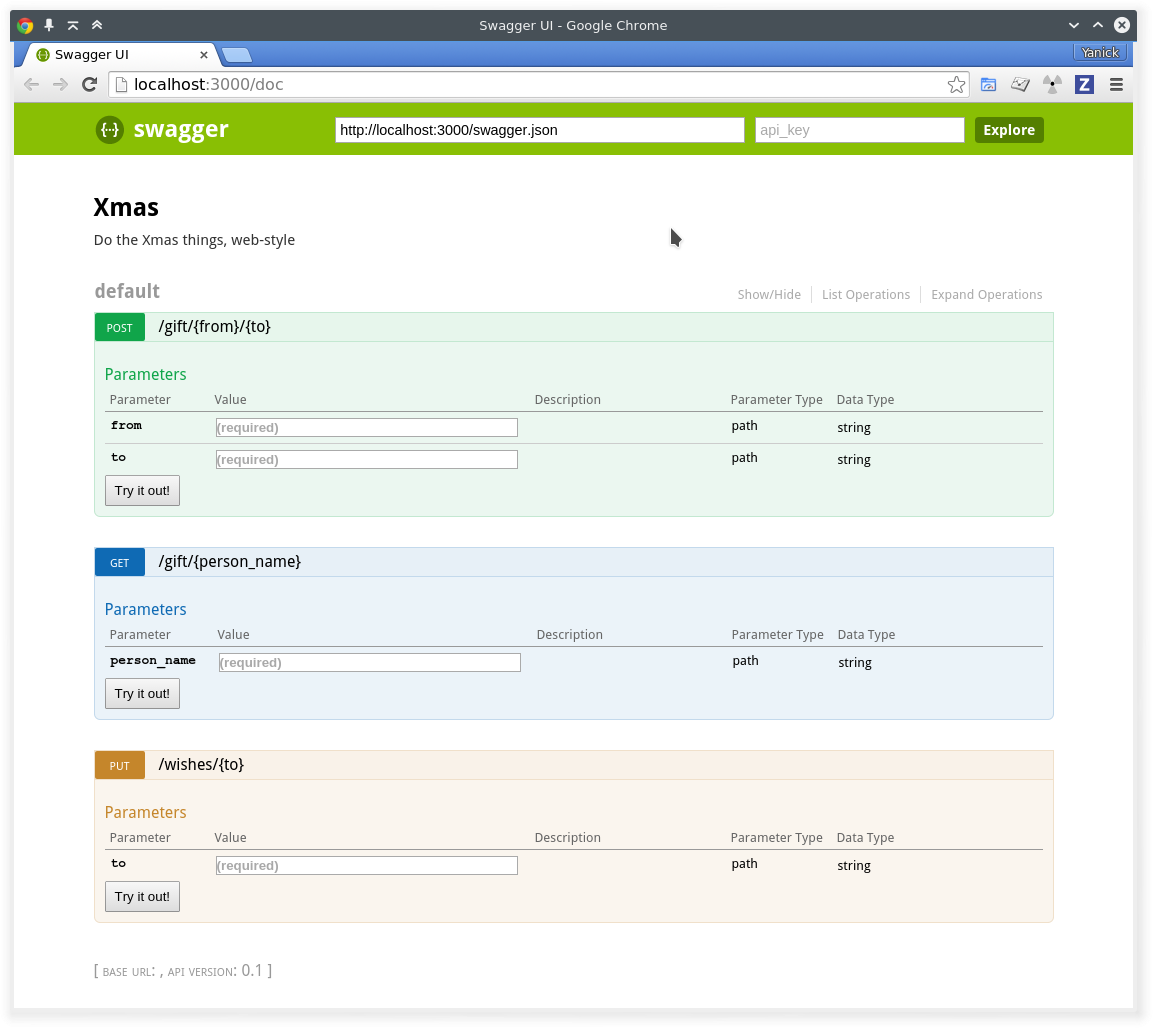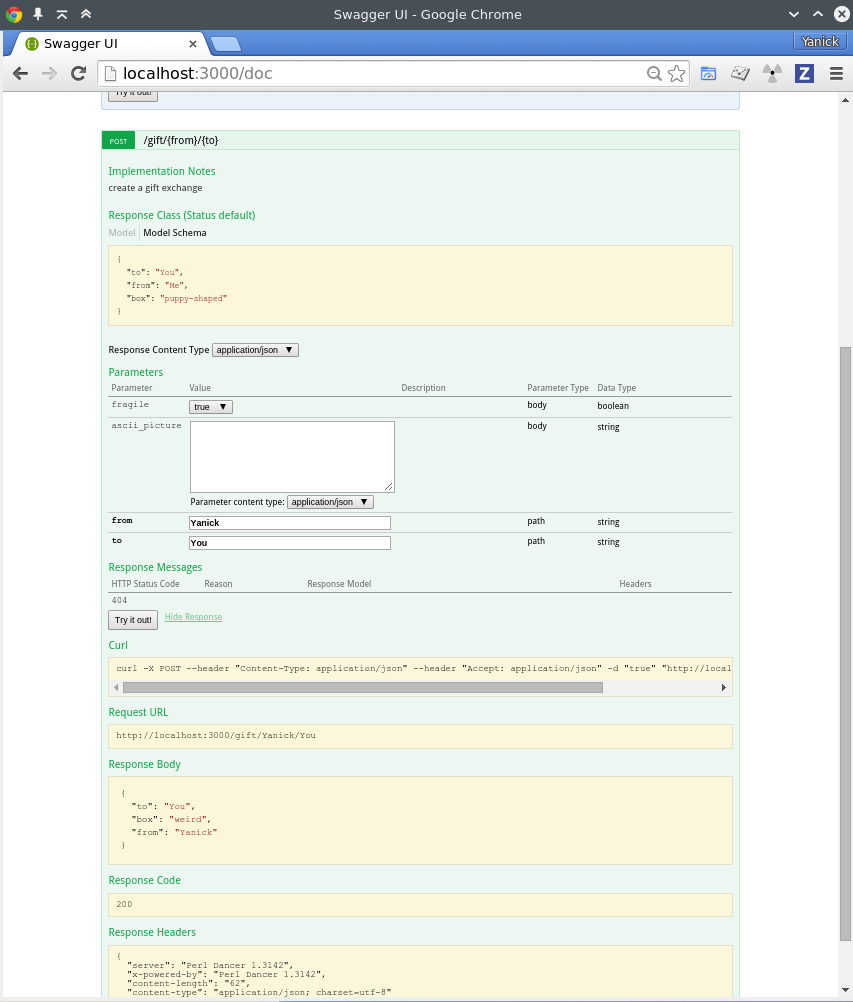Dance With Swagger
Dance With Swagger
A REST API is as good as its documentation. But considering that documentation is the proverbial boiled spinach sadly sitting on the very periphery of the the dev’s plate, it’s no wonder that most of us are always on the lookout to make its production more… palatable.
There are several solutions that help generating decent documentation from the code itself. One that is doing the rounds these days is Swagger. It has reasonable specs, its native formats are the familiar JSON or YAML, and it comes with an ecosystem that already carry an online editor, a HTML renderer, validators and other goodies.
Writing the Swagger document for a REST API is not that hard, but if you do it manually, there’s a lot of duplication between the code and the doc itself. And you know me and how lazy I am. That wouldn’t do. So… say hi! to .
The Out-of-the-Box Experience
So, what does this plugin gives you. Well, imagine you have the following wee Dancer app:
package Xmas;
# ABSTRACT: Do the Xmas things, web-style
use Dancer;
our $VERSION = '0.1';
get '/gift/:person_name' => sub { ... };
post '/gift/:from/:to' => sub { ... };
put '/wishes/:to' => sub { ... };
1;We change config.yml to have serializer: JSON, and add two lines to the
app itself:
package Xmas;
# ABSTRACT: Do the Xmas things, web-style
use Dancer;
use Dancer::Plugin::Swagger;
our $VERSION = '0.1';
get '/gift/:person_name' => sub { ... };
post '/gift/:from/:to' => sub { ... };
put '/wishes/:to' => sub { ... };
swagger_auto_discover;
1;And then, just like that:
$ curl http://localhost:3000/swagger.json
{
"swagger" : "2.0",
"info" : {
"version" : "0.1",
"description" : "Do the Xmas things, web-style",
"title" : "Xmas"
},
"paths" : {
"/gift/{from}/{to}" : {
"post" : {
"parameters" : [
{
"name" : "from",
"in" : "path",
"type" : "string",
"required" : true
},
{
"required" : true,
"type" : "string",
"in" : "path",
"name" : "to"
}
]
}
},
"/gift/{person_name}" : {
"get" : {
"parameters" : [
{
"required" : true,
"type" : "string",
"in" : "path",
"name" : "person_name"
}
]
}
},
"/wishes/{to}" : {
"put" : {
"parameters" : [
{
"in" : "path",
"name" : "to",
"type" : "string",
"required" : true
}
]
}
}
}Think that is nifty? Well, hold on to yours Christmas socks, ‘cause if we go
and visit http://localhost:3000/doc instead:

The plugin gathered all our routes, figured out their route parameters, got
the name of the app, its description, its version, and yes, the try it out
buttons work.
Yes. What you are hearing are angels singing. You’re welcome.
More goodies
The module is still very young, but it already have quite a few goodies includes. The UI can be toggled on and off, the url locations are configurable. You can already tell the auto-discovery mechanism to skip some routes. And documentation that can’t be figured out from the route itself is given by prefixing any route with `swagger_path …‘. Like so:
swagger_path {
description => 'create a gift exchange',
parameters => [
{ name => 'fragile', in => 'body', type => 'boolean' },
{ name => 'ascii_picture', in => 'body', type => 'string' },
],
responses => {
default => {
description => "gift has been recorded",
example => { from => 'Me', to => 'You', box => 'puppy-shaped' },
schema => { '$id' => '#/definitions/gift_response' },
},
404 => { template => sub {
+{ error => "giftee or gifter '$_[0]' not found" } }
},
},
},
post '/gift/:from/:to' => sub { ... };Yes, it’s a little verbose. For the moment, it follows pretty closely the Swagger specs, but I expect that in future releases I’m going to inject some DWIMery in there.
Not that there isn’t already some DWIMery present. That example, up there?
It’ll be converted to the right format, JSON or YAML, in the docs for you.
Oh, and that template? It’s to go with the plugin keyword
swagger_template, so that you can do:
post '/gift/:from/:to' => sub {
...;
return swagger_template 404 => $missing_person
if $missing_person
...;
};It’s not a huge thing, but it’ll do wonders to ensure that the route responses
are consistent. Even moreso once I merge support for JSON Schema validation
(yes, there was a reason why I did ). And for that,
the swagger_definition keyword is already present:
swagger_definition gift_response => {
type => 'object', required => [qw/ from to /]
};So, yeah, lots of stuff to improve on, but already, look at what this code is already adding to our UI:

Isn’t GLORIOUS?